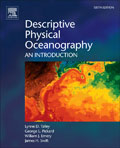About the Author
Lynne Talley is a Professor of Oceanography at Scripps Institution of Oceanography (SIO), University of California San Diego. This fully updated edition of Descriptive Physical Oceanography grew out of the course that she has taught over the years to graduate students in all disciplines of oceanography at SIO. Lynne is a seagoing oceanographer with research interests in the water mass distributions and circulation of the world ocean. She is a graduate of Oberlin College (B.A. in physics) and the Woods Hole Oceanographic Institution/Massachusetts Institute of Technology Joint Program (Ph.D. in physical oceanography). She has been an editor of the Journal of Physical Oceanography and has served on the Intergovernmental Panel on Climate Change (AR4 and AR5), many committees of the National Academy of Sciences, and planning and steering committees for major field programs, including the World Ocean Circulation Experiment (WOCE) of the 1990s and the U.S. Global Ocean Carbon and Repeat Hydrography Program. She is a Fellow of the American Academy of Arts and Sciences, the American Geophysical Union, the Oceanography Society, and the American Meteorological Society.
George Pickard (1913-2007) was a Professor of Oceanography at the University of British Columbia (UBC) and was Director of the UBC Institute of Oceanography from 1958 to 1978. This sixth edition of Descriptive Physical Oceanography is dedicated to his memory. George wrote DPO as an outgrowth of his teaching at UBC. He received his B.A. and his Ph.D. in physics from Oxford. He was appointed to the UBC physics department after service in WWII. George was a Fellow of the American Association for the Advancement of Science, the Royal Society of Canada, and the National Geographic Society. A biography, CV, bibliography, memories (written by Dr. Paul LeBlond, University of British Columbia and by the family of Dr. Pickard), and some pictures are included here.
William (Bill) Emery received his PhD in Physical Oceanography from the University of Hawaii in 1975. After working at Texas A&M University, he moved to the University of British Columbia in 1978 where he created a Satellite Oceanography facility and education/research program. He was appointed full professor in Aerospace Engineering Sciences at the University of Colorado, Boulder Campus in 1987. He is an Adjunct Professor of Informatics at Tor Vergata University in Rome, Italy. He has authored over 170 refereed publications and two major textbooks. He is a fellow of the IEEE, a member of the administrative committee of the Geoscience and Remote Sensing Society of the IEEE. He received the GRSS Educational Award in 2004 and its Outstanding Service Award in 2009. He is a Fellow of the American Meteorological Society (2010) and the American Astronautical Society (2011). He was recently elected a Fellow of the American Geophysical Union (2012).
James Swift is a Research Oceanographer at SIO. The Java OceanAtlas examples that are a new aspect of this edition of Descriptive Physical Oceanography are an outgrowth of his long-term activities in collecting, analyzing, and archiving hydrographic data. Jim is a seagoing oceanographer with research interests in Arctic Ocean and Nordic Seas water masses and circulation. He frequently leads expeditions to all parts of the world ocean. His B.S. in physics is from Case Western Reserve University, and his Ph.D. is in physical oceanography from the University of Washington. He is the director of the CLIVAR and Carbon Hydrographic Data Office (formerly the WOCE Hydrographic Programme Office), and scientific advisor of SIO’s Oceanographic Data Facility. He oversees operations of the NSF-supported university contribution to the U.S. Global Ocean Carbon and Repeat Hydrography Program.

